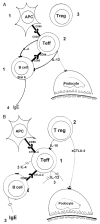Idiopathic nephrotic syndrome and atopy: is there a common link? - PubMed (original) (raw)
Review
Idiopathic nephrotic syndrome and atopy: is there a common link?
Maher Abdel-Hafez et al. Am J Kidney Dis. 2009 Nov.
Abstract
Numerous reports during the last 60 years have reported a strong association between idiopathic nephrotic syndrome and atopic disorders. Idiopathic nephrotic syndrome can be precipitated by allergic reactions and has been associated with both aeroallergens (pollens, mold, and dust) and food allergies. Patients with idiopathic nephrotic syndrome also may show increased serum immunoglobulin E (IgE) levels. A review of the literature suggests that although some idiopathic nephrotic syndrome cases may be associated with allergies, evidence that it is a type of allergic disorder or can be induced by a specific allergen is weak. Rather, it is likely that the proteinuria and increased IgE levels in patients with idiopathic nephrotic syndrome are caused by increased levels of interleukin 13 observed in these patients. Recent studies suggest that interleukin 13, a known stimulator of IgE response, may mediate proteinuria in patients with minimal change disease because of its ability to directly induce CD80 expression on the podocyte.
Figures
Figure 1
(A) (1) Antigen-presenting cells (APCs) and activated B cells express CD80, which binds to CD28 on the (2) T effector (Teff) cellular membrane. In the absence of suppression by (3) T regulatory (Treg) cells, T effector cells release interleukin 4 (IL-4) and IL-13. These 2 cytokines trigger (4) the switch from immunoglobulin M (IgM) to IgE in the B cell. (B) T effector cells express cytotoxic T-lymphocyte antigen-4 (CTLA-4), which will compete with CD28 for CD80, resulting in (1) decreased activation of T effector cells. In addition, (2) T regulatory cells suppress T effector activation by releasing IL-10 and soluble CTLA-4. These combined events result in decreased production of IL-4, IL-13, and (3) IgE.
Figure 2
In patients with minimal change disease, activation of T effector (T eff) cells is by (1) antigen-presenting cells (APCs) after exposure to microbial pathogen-associated molecular patterns (PAMP). It is unknown whether activated B cells have a role (?). (2) Activated T effector cells release cytokines, including interleukin 13 (IL-13). IL-13 will induce the switch from immunoglobulin M (IgM) to IgE in B cells and expression of (3) CD80 by podocytes. A postulated defect in (4) T regulatory (T reg) cell function will allow T effector cells to continue secreting the pathogenetic cytokine.
Similar articles
- [Nephrotic syndrome and hypersensitivity to pollens (author's transl)].
Lagrue G, Laurent J. Lagrue G, et al. Nouv Presse Med. 1982 Apr 24;11(19):1479-81. Nouv Presse Med. 1982. PMID: 7079169 French. - Basophil sensitisation in idiopathic nephrotic syndrome.
Pirotzky E, Hieblot C, Benveniste J, Laurent J, Lagrue G, Noirot C. Pirotzky E, et al. Lancet. 1982 Feb 13;1(8268):358-61. doi: 10.1016/s0140-6736(82)91391-5. Lancet. 1982. PMID: 6120348 - Minimal change disease: a CD80 podocytopathy?
Ishimoto T, Shimada M, Araya CE, Huskey J, Garin EH, Johnson RJ. Ishimoto T, et al. Semin Nephrol. 2011 Jul;31(4):320-5. doi: 10.1016/j.semnephrol.2011.06.002. Semin Nephrol. 2011. PMID: 21839364 Review. - [Minimal change nephrotic syndrome : new insights into disease pathogenesis].
Audard V, Lang P, Sahali D. Audard V, et al. Med Sci (Paris). 2008 Oct;24(10):853-8. doi: 10.1051/medsci/20082410853. Med Sci (Paris). 2008. PMID: 18950582 Review. French.
Cited by
- A nomogram to predict the risk of relapse in patients with minimal change disease: a retrospective cohort study.
Wang L, Yao Q, Zhang Y, Zhang X, Hu M, Chen J, Li X, Chen J, Li H. Wang L, et al. Ren Fail. 2024 Dec;46(2):2423007. doi: 10.1080/0886022X.2024.2423007. Epub 2024 Nov 6. Ren Fail. 2024. PMID: 39505492 Free PMC article. - A novel flow cytometry panel to identify prognostic markers for steroid-sensitive forms of idiopathic nephrotic syndrome in childhood.
Riganati M, Zotta F, Candino A, Conversano E, Gargiulo A, Scarsella M, Lo Russo A, Bettini C, Emma F, Vivarelli M, Colucci M. Riganati M, et al. Front Immunol. 2024 Apr 2;15:1379924. doi: 10.3389/fimmu.2024.1379924. eCollection 2024. Front Immunol. 2024. PMID: 38629076 Free PMC article. - Exploring the significance of interleukin-33/ST2 axis in minimal change disease.
Kanazawa N, Iyoda M, Suzuki T, Tachibana S, Nagashima R, Honda H. Kanazawa N, et al. Sci Rep. 2023 Oct 31;13(1):18776. doi: 10.1038/s41598-023-45678-z. Sci Rep. 2023. PMID: 37907612 Free PMC article. - "Idiopathic" minimal change nephrotic syndrome: a podocyte mystery nears the end.
Chugh SS, Clement LC. Chugh SS, et al. Am J Physiol Renal Physiol. 2023 Dec 1;325(6):F685-F694. doi: 10.1152/ajprenal.00219.2023. Epub 2023 Oct 5. Am J Physiol Renal Physiol. 2023. PMID: 37795536 Free PMC article. Review. - [Diagnosis and treatment of Minimal Change Disease in adults-2023].
Gauckler P, Regele H, Eller K, Säemann MD, Lhotta K, Zitt E, Neumann I, Rudnicki M, Odler B, Kronbichler A, Windpessl M. Gauckler P, et al. Wien Klin Wochenschr. 2023 Aug;135(Suppl 5):628-637. doi: 10.1007/s00508-023-02258-5. Epub 2023 Sep 20. Wien Klin Wochenschr. 2023. PMID: 37728648 Free PMC article. German.
References
- Shalhoub RJ. Pathogenesis of lipoid nephrosis: A disorder of T-cell function. Lancet. 1974;2:556–560. - PubMed
- Koyama A, Fujisaki M, Kobayashi M, Igarashi M, Narita M. A glomerular permeability factor produced by human T cell hybridomas. Kidney Int. 1991;40:453–460. - PubMed
- Kay AB. Allergy and allergic diseases. First of two parts. N Engl J Med. 2001;344:30–37. - PubMed
- Fanconi G, Kousmine C, Frisch B, Knecht W. Prognosis of the nephrotic syndrome. Helv Pediatr Acta. 1951;6:219–224. - PubMed
- Kark RM, Pirani CL, Pollak VE, Muehrcke RC, Blainey JD. The nephrotic syndrome in adults: A common disorder with many causes. Ann Intern Med. 1958;49:751–754. - PubMed
Publication types
MeSH terms
Substances
Grants and funding
- R01 DK052121/DK/NIDDK NIH HHS/United States
- R01 DK052121-13/DK/NIDDK NIH HHS/United States
- R01 HL068607/HL/NHLBI NIH HHS/United States
- R01 HL068607-08/HL/NHLBI NIH HHS/United States
LinkOut - more resources
Full Text Sources

